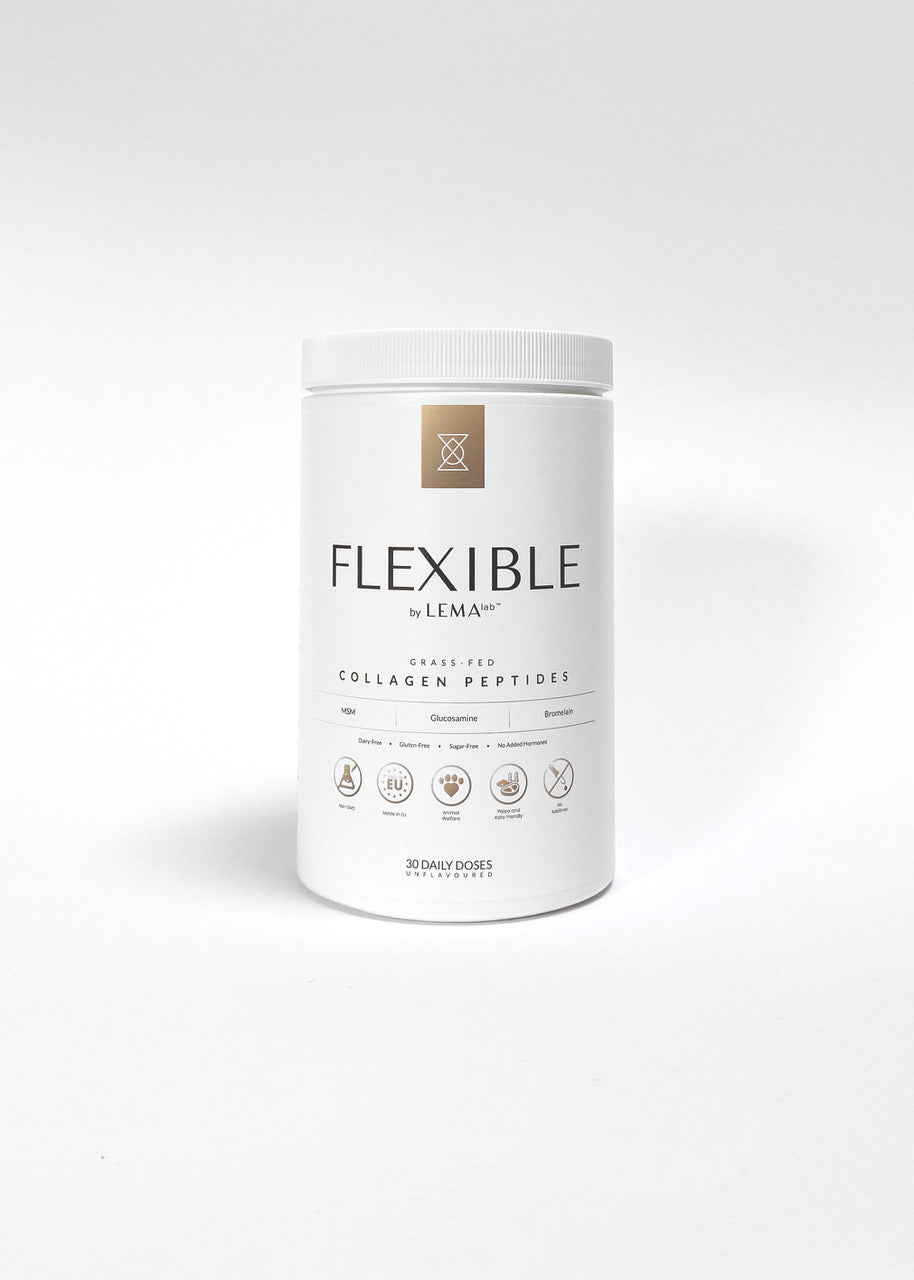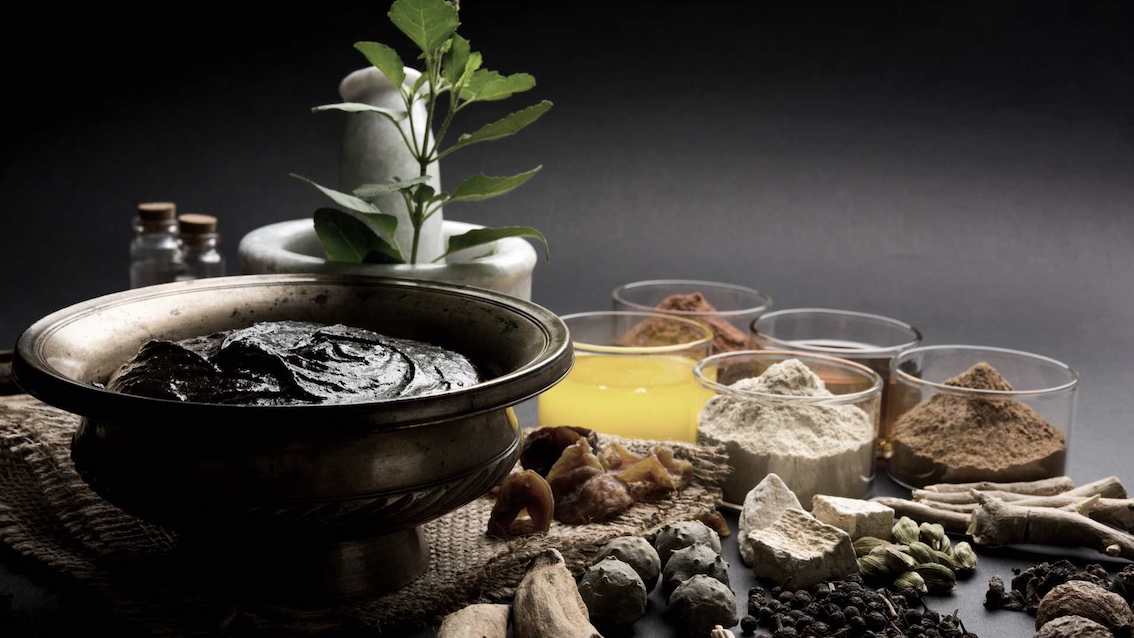
GUIDE: 10 WAYS TO USE FLEXIBLE BY LEMAlab + RECIPES
Collagen is the most abundant protein in the human body, and it is responsible for providing structure and elasticity. It is found in bones, connective tissue, tendons and ligaments.
Natural collagen production decreases with age, which can lead to lost bone density, thinner skin and weaker hair and nails. [1] [2]
Studies reveal that taking collagen supplements can drastically slow this process, improve skin elasticity and prevent bone loss. [3] [4]
There are many types of collagen supplements, including capsules, liquid and powder. Powder is the king of collagen supplements, as it can be added to foods or drinks and it is easy to absorb.
FLEXIBLE by LEMAlab is a high-quality protein powder. It contains hydrolysed bovine collagen peptides from pasture-raised animals, with complementary ingredients Methylsulfonylmethane, Bromelain and Glucosamine Sulphate.
Methylsulfonylmethane, or MSM, is known for its powerful anti-inflammatory effects offering reductions in muscle damage and soreness.
Glucosamine may reduce the rate of collagen (joint tissue) degradation and symptoms of osteoarthritis.
Bromelain is an enzyme that helps with digestion and may offer further anti-inflammatory benefits for those with digestion issues.
Hydrolysed collagen refers to collagen that has been broken down into smaller peptides, which ensures that your body will absorb the product more efficiently.
In this mini-guide, we share with you 10 different ways to use collagen powder. Since FLEXIBLE is unflavoured and contains no additives or sweetener, you can be creative in the ways you use it.
1. Make collagen water

The easiest way to take collagen powder is to simply add it to your water. Although FLEXIBLE is unflavoured, in water alone you may dislike the texture or notice a slight taste that might be unpleasant to some.
Add a scoop of FLEXIBLE to a full shaker bottle, shake for 15 seconds and you are ready to go. You just added more water and collagen to your nutrition plan for the day in less than one minute.
When to drink collagen water
One very convenient option is to have your collagen water in the morning, before your breakfast or coffee. You don't have to consume it on an empty stomach, although you can since the peptides are hydrolysed, therefore easy to digest.
Drinking water first thing in the morning helps rehydrate the body and boosts alertness.
Furthermore, it is a great way to kick start your daily tasks and ensures that you will not forget to take your collagen dose for the day.
Keep in mind that the taste might be a bit weird when you first try it but the benefits are worth it!
2. Add collagen to your coffee

Coffee is one of the most popular hot beverages in the world. It tastes amazing, increases energy levels and enhances mood.
There are many different coffee drinks, including espresso, cappuccino, latte macchiato, caffè Americano and espresso macchiato. No matter which one is your favourite, you can add a spoon of collagen powder to your coffee drink and it will dissolve perfectly.
How to make collagen cappuccino:
- Pour a shot of espresso into a serving glass.
- Add steamed milk (regular or plant-based) and a spoon of FLEXIBLE.
- Mix until collagen powder dissolves and top with milk foam.
- Garnish with cacao powder or a pinch of cinnamon. (optional)
When to have a collagen coffee drink
Any time from the morning until the afternoon is a good time to have your collagen coffee. Avoid drinking coffee 5-6 hours before going to bed, as it can negatively affect your sleep.
3. Switch to collagen smoothies

If you like being creative with smoothies in the first place, you will love this idea.
Smoothies are easy to prepare, delicious and deliver a variety of healthy nutrients to your body. Made with whole vegetables and/or fruit, smoothies are a simple way to drink and absorb your vitamins and minerals.
Adding a spoon of collagen powder to your smoothie is a quick step that can add extra protein to your diet. Plus, the vitamin C from fruit in smoothies contributes to better collagen absorption [5].
How to make a collagen smoothie:
- Place frozen or fresh fruit and vegetables in a blender.
- Pour a cup of milk or nut milk.
- Add a scoop of FLEXIBLE.
- Add some seeds and/or nuts.
- Blend everything until smooth and creamy.
Six delicious fruit and vegetables combinations to try:
- One frozen banana, a handful of spinach and 100g frozen raspberries
- One apple, one carrot, 100g frozen mixed berries and a tablespoon of fresh parsley
- One pear, 100g frozen blueberries and a few fresh mint leaves
- Two carrots, a handful of kale and 150g frozen pineapple
- One frozen peach, 100g frozen mango and a few strawberries
- One kiwi, 100g red beet and 100g frozen blackberries
When to have a collagen smoothie.
Collagen rich smoothies make a perfect breakfast or afternoon snack. They can be easily transferred to bottles and consumed on the go.
4. Add collagen to your tea

Drinking a cup of tea every day is a great way to increase your water intake and enjoy a tasty hot beverage. Black and green teas are rich in antioxidants that detoxify the body and promote overall health [6].
How to make collagen tea:
- Prepare your favourite tea as usual.
- Add a spoon of FLEXIBLE and stir until the powder dissolves completely.
When to have a collagen tea
Green and black teas are suitable for the morning or afternoon, as they contain caffeine.
Herbal or fruit teas with added collagen can be consumed before bed. Collagen is rich in the protein called glycine, which is known for improving the quality of sleep [7].
The best herbs for bedtime tea include lavender, chamomile, valerian root and passionflower.
5. Collagen oatmeal

Oatmeal is one of those breakfasts that can be consumed every day without getting tired of it.
Oats are a powerful source of fibre and important micronutrients, including vitamin B1, magnesium, phosphorous and manganese [8]. With the countless possibilities to make a different oatmeal bowl, you can always enjoy a flavourful and healthy breakfast that takes minutes to prepare.
Oats contain slow-digestible carbohydrates and more protein than most other grains. Adding a spoon of collagen powder to your oatmeal can help you start your day with a high-protein and energy-boosting breakfast.
Furthermore, protein helps prevent post-meal blood glucose spikes and keeps you fuller for longer. Blood sugar spikes can lead to mood swings, fatigue and headache, so try to keep your glucose levels as stable as possible [9].
How to make collagen oatmeal:
*The regular portion size of oats is 50g, but you can adjust this according to your needs. The ratio of oats to liquid is 1:2.
*This recipe is for rolled oats, which is the most basic type of oatmeal you can find. Avoid products with added sugar or artificial sweeteners.
- Bring 100g of liquid to a boil and lower the heat to medium-low. You can use water, milk or a combination of both. You can swap regular milk for plant-based option.
- Pour in 50g of old-fashioned oats and a pinch of salt. Cook until the oatmeal thickens, stirring occasionally. It should take about three to five minutes.
- Turn the heat down and add a spoon of FLEXIBLE. Stir well until the powder dissolves.
- Transfer the oatmeal to a bowl and top with fruit and nuts of your choice. You can also add more flavour with a sweetener, cacao powder or cinnamon.

Sweet treats are always a good idea when they are healthy. Baked cookies make the perfect afternoon snack to accompany your coffee or tea. You can also make cookies before a trip and pack them to eat on the road.
Adding collagen to your baked goods is a delicious way to have more protein in your diet and take care of your skin, bones and joints. They are your clean option to processed protein bars.
Keep in mind that the glucosamine and bromelain molecules in FLEXIBLE are sensitive to extreme heat. These cookies will still provide your body with collagen and MSM, but the other ingredients might lose some of their properties.
How to make cacao nibs collagen cookies:
For these low carb cookies, you will need less than ten ingredients. Here is the recipe for twelve cookies.
Ingredients
- 25g collagen powder FLEXIBLE
- 25g almond flour
- 20g coconut sugar or a pinch of stevia powder
- 5g baking powder
- A pinch of salt
- 1 egg
- 25g unsweetened hazelnut butter
- 5 drops vanilla extract
- 20g raw cacao nibs, crushed
Instructions
- Combine collagen, almond flour, coconut sugar, baking powder and salt in a medium-sized mixing bowl.
- Mix in eggs, hazelnut butter, vanilla drops and cacao nibs.
- Let the dough firm up in the fridge for 20 minutes.
- Preheat the oven to 175 C.
- Form 12 cookies and place them on a lined baking tray.
- Bake in the oven for 10 to 12 minutes.
- Remove from the oven and transfer the cookies to a cooling rack.
7. Collagen raw bites

Raw bites are another delicious dessert, but it does not require any baking. This gives them an advantage over the baked goods, because there is no loss of the anti-inflammatory properties of glucosamine.
These nutritious balls are awesome for the hot summer days because they are light, healthy, filling, replenish energy at times when you may not feel like eating much. Raw bites that are packed with collagen deliver a major dose of healthy fats, protein (from collagen proteins) and fibre. Even though they are super easy to make, these bites taste amazing and can satisfy any sweet tooth.
How to make collagen energy bites
The recipe is for twelve balls. Consume two balls for your daily dose of FLEXIBLE.
Ingredients
- 65g sesame seeds
- 66g collagen powder FLEXIBLE
- 200g unsweetened almond butter
- 50g chia seeds
- 5 drops vanilla extract
- 50g coconut unsweetened shreds, plus extra for coating
- 4 dates, pitted
- 20g raw cacao nibs, crushed
- 3g cinnamon (optional)
Instructions
- In a food processor, blend all of the ingredients until smooth.
- Form the batter into small balls using a tablespoon.
- Sprinkle the excess coconut onto a plate and roll the balls over the plate to coat.
- Refrigerate the raw bites for 3 hours and serve.
You can store these raw bites in the fridge for up to fourteen days.
8. Collagen matcha latte
Matcha is a Japanese green tea powder that is extremely rich in catechins. Catechins are plant compounds in tea that act as natural antioxidants.
Compared to other green teas, the number of certain catechins in matcha is up to 137 times higher. These powerful compounds reduce cell damage and protect from chronic diseases [10].
Matcha also contains caffeine and L-theanine. L-theanine is an amino acid that can enhance cognitive performance and alertness in combination with caffeine. Research suggests that matcha benefits memory, reaction time and attention, thanks to these components [11].
Adding a spoon of collagen to a matcha drink is a great way to increase the health benefits you get from your tea while enjoying your daily dose of collagen.
You can have a classic collagen matcha tea or try the latte option.
How to make collagen matcha latte:
- In a serving mug, add matcha powder and 20ml hot water.
- Whisk with until completely dissolved.
- Heat 70ml milk (or alternative) until it’s warm but do not boil the milk.
- Add a spoon of FLEXIBLE to the hot milk and blend. If you do not like milk foam, you can stir the collagen powder into the milk without blending.
- Pour milk mixture into the mug with matcha and stir to combine.
When to have a collagen matcha drink
Collagen matcha drinks are a fantastic way to get your morning started. Matcha can also give you a boost during working, so give it a try on a busy day.
9. Bulletproof collagen drink

Bulletproof drinks refer to coffee or tea with added oil. It recently gained more popularity among keto diet followers as a way to replace breakfast or suppress hunger during fasting.
However, it can be consumed just for its amazing taste, without following a fasting protocol or ketogenic diet.
The main ingredients in a bulletproof drink are:
- Coffee or tea
- Grass-fed butter (you can skip this ingredient if you are following a dairy-free diet)
- Coconut oil or MCT oil. MCT oil is usually extracted from coconut oil and it refers to medium-chained triglyceride. It is said that MCTs are digested more easily than longer-chain fatty acids.
Keep in mind that giving up a nutritious breakfast for a bulletproof coffee or tea might not be the best option for everyone. The original recipe that aims to replace breakfast contains a lot more fat, and therefore more calories than the option below.
This recipe allows you to enjoy a creamy collagen drink without having to take a whole meal out of your nutrition plan.
How to make a bulletproof collagen drink:
- Pour a cup of coffee or tea in a blender.
- Add a spoon of FLEXIBLE, ½ tbsp grass-fed butter and ½ tbsp coconut oil or MCT oil.
- Add 10ml of milk or plant-based milk (optional).
- Blend for 20 seconds.
When to have a collagen bulletproof drink
You can drink your coffee or tea this way after a meal that was poor in healthy fats, or when you are in the mood for a creamy and filling warm drink. Take into account that it contains caffeine.
10. Add collagen to your soup

If you love soups, why not add your collagen supplement to it! It will dissolve instantly and it does not require any specific preparation.
Packing your soup with collagen is especially helpful if you want to add protein to a vegetable soup.
How to make a collagen rich soup:
- Prepare your favourite soup and serve in a soup bowl.
- Simply add a spoon of FLEXIBLE and stir.
When to have a collagen soup
There is literally no bad time to have a collagen rich soul-warming soup. It is a great option for lunch and dinner. Consider making it more often during the flu season to boost your immune system.
With countless ways to use collagen powder, FLEXIBLE can easily become your favourite supplement. Enjoy healthy skin and take a good care of your bones and joints. Your body will thank you with pain-free movements and high energy levels.
Final Thoughts
Consume FLEXIBLE daily for best results and note the improvements on your inflammation and pain level, soreness and overall better range of motion as well as skin, hair and nail quality. Although results differ, you should start seeing significant improvements between 4 to 12 weeks.
Have a FLEXIBLE day and a pain-free life!
REFERENCES
[1] James Varani, Michael K. Dame, Laure Rittie, Suzanne Fligiel, Sewon Kang, Gary Fisher, John Voorhees, ‘Decreased Collagen Production in Chronologically Aged Skin’
[2] C. Castelo-Branco, F. Pons, E. Gratacós, A. Fortuny, J. A. Vanrell, J, González-Merlo, ‘Relationship between skin collagen and bone changes during aging’
[3] E. Proksch, D. Segger, J. Degwert, M. Schunck, V. Zague, S. Oesser, ‘Oral supplementation of specific collagen peptides has beneficial effects on human skin physiology: a double-blind, placebo-controlled study’
[4] S. Kumar, F. Sugihara, K. Suzuki, N. Inoue, S. Venkateswarathirukumara, ‘A double-blind, placebo-controlled, randomised, clinical study on the effectiveness of collagen peptide on osteoarthritis’
[5] J. Moores, ‘Vitamin C: a wound healing perspective’, Accessed: 4 June 2021.
[6] Peluso, M. Serafini, ‘Antioxidants from black and green tea: from dietary modulation of oxidative stress to pharmacological mechanisms’
[7] M. Bannai, N. Kawai, ‘New Therapeutic Strategy for Amino Acid Medicine: Glycine Improves the Quality of Sleep’
[8] Oats, Nutrition Facts & Calories, NutritionData
[9] M. Beaudry, M. C. Devries, ‘Nutritional Strategies to Combat Type 2 Diabetes in Aging Adults: The Importance of Protein’
[10] Weiss, C. Anderton, ‘Determination of catechins in matcha green tea by micellar electrokinetic chromatography’
[11] Giesbrecht, A. Rycroft, M. J. Rowson, ‘The combination of L-theanine and caffeine improves cognitive performance and increases subjective alertness’














1 comment
Best way is added to homemade stock! Did tried the other ones, but nothing beats a good stock 🥰
Sandra Madge
Leave a comment
This site is protected by hCaptcha and the hCaptcha Privacy Policy and Terms of Service apply.